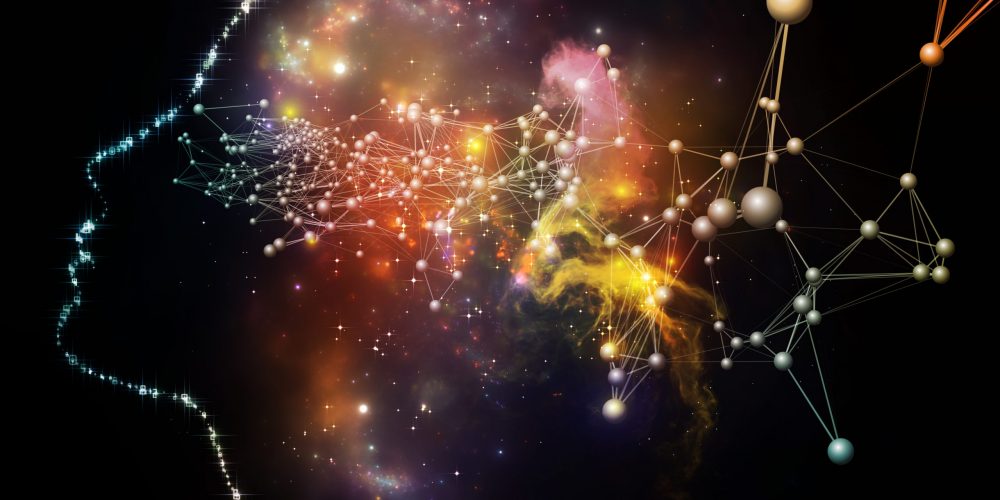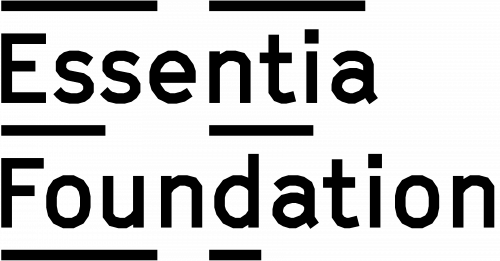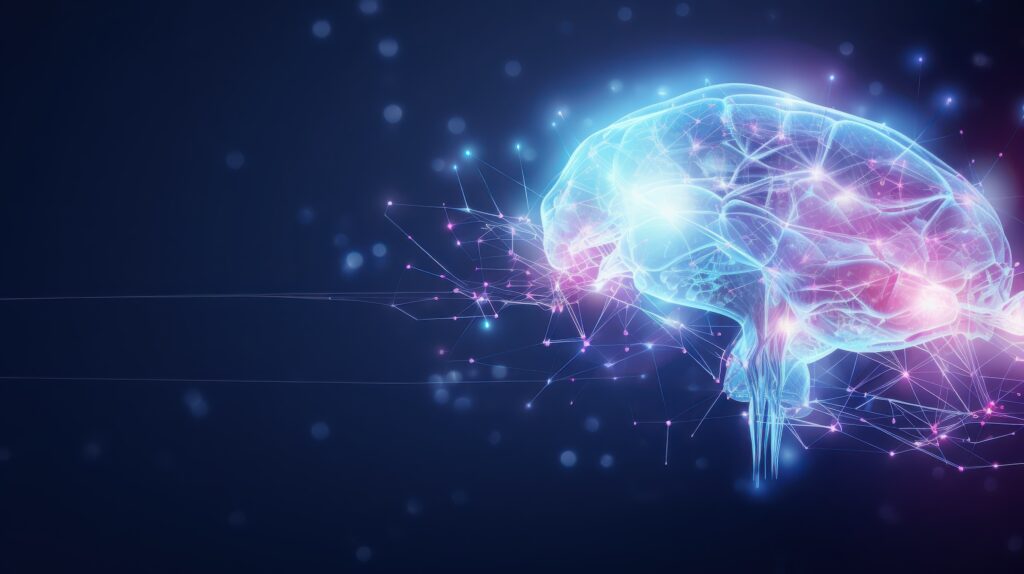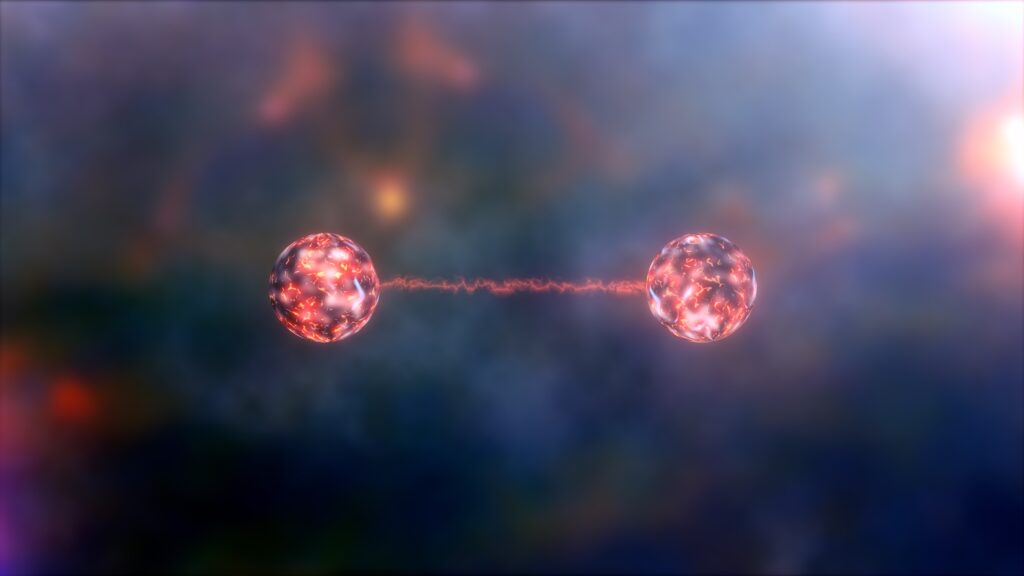Relational Quantum Dynamics and Indra’s Net: A non-dual understanding of quantum reality
Reading | Quantum Physics
![]() Prof. Arash E. Zaghi, PhD, PE, SE | 2025-05-16
Prof. Arash E. Zaghi, PhD, PE, SE | 2025-05-16

Professor Zaghi introduces Relational Quantum Dynamics (RQD), a further development of Carlo Rovelli’s Relational Quantum Mechanics (RQM) with a solid mathematical and metaphysical basis. RQD circumvents the infinite regress inherent to RQM (everything being constituted of relations between meta-relations, and these consisting of relations between meta-meta-relations, etc., ad infinitum) by proposing that, although all physical entities are indeed relational, the relations—and even spacetime itself—arise within an underlying field awareness.
Quantum physics, for all its precision, has always grappled with a foundational ambiguity: what exactly constitutes reality when we are not observing it? Traditional interpretations fall short in offering a satisfying resolution, often resorting to external observers or subjective collapses to account for measurement outcomes. Carlo Rovelli’s Relational Quantum Mechanics (RQM) offers a distinct perspective [1-3]; it abandons absolute, observer-independent physical states altogether. Instead, quantum systems possess states only relative to specific interactions. In this view, reality becomes a network of relations rather than isolated physical entities or universal observers. Rovelli’s interpretation powerfully addresses quantum paradoxes like Wigner’s friend scenarios (as I will discuss later) by asserting that different observers can have valid yet seemingly contradictory descriptions, reconciled only when interactions occur.
Yet, while RQM elegantly solves paradoxes, it stops at a mechanical description, leaving open deeper metaphysical questions. Relational Quantum Dynamics (RQD) goes further by integrating consciousness and information directly into this relational ontology [4]. Specifically, it proposes that quantum interactions are not merely passive physical processes but intrinsic “awareness updates,” whereby each interaction represents a primitive act of mutual awareness between interacting systems. Quantum events become experiences themselves, blurring the lines between observer and observed, matter and consciousness [5-6].
Relational Quantum Dynamics: Quantum information meets awareness
The innovation of RQD lies in its rigorous integration of quantum theory with Integrated Information Theory (IIT) [7-8], a prominent model from cognitive science developed to quantify consciousness. IIT suggests consciousness emerges naturally from systems with highly integrated internal information—like the human brain. RQD adopts IIT’s approach, defining a quantitative measure of awareness arising during quantum interactions. Two measures are central:
Quantum Mutual Information (I): Quantifies the correlation between two interacting quantum systems. A high mutual information indicates systems that strongly reflect each other’s states.
Integrated Information (Φ): Measures the internal informational coherence or holistic integration within each quantum system.
RQD combines these insights to define an “awareness metric,” calculated by multiplying the mutual information exchanged during an interaction by the integrated information within the interacting systems. From this viewpoint, every interaction is fundamentally an event within awareness itself. When highly complex systems interact, the resulting event carries greater depth and richness due to their extensive internal informational integration. Conversely, simpler systems with minimal internal integration generate interactions of lower complexity. This perspective does not imply a separate observer watching a quantum event; rather, all interactions are equally direct expressions of the same underlying field of awareness. The difference is purely in how deeply the relational field of awareness integrates and reflects itself through each unique interaction.
RQD formally maps quantum processes to updates of awareness states through a mathematical framework based on category theory. Category theory is a branch of mathematics that focuses on the relationships and transformations between different structures, rather than the structures themselves. This perspective is particularly valuable in quantum mechanics, because it allows physicists to model complex quantum processes as interconnected systems by emphasizing how different parts interact and compose to form a whole. By using category theory, we can represent quantum states and operations in a way that highlights their compositional nature, making it easier to analyze and understand the behavior of quantum systems. This approach is especially useful when dealing with entangled systems, where the properties of the whole cannot be fully understood by examining the parts in isolation. RQD introduces a categorical functor [Editor’s note: a mathematical operator between categories] that translates quantum events (physical transformations) into updates in states of awareness, preserving identities and sequential consistency.
This robust mathematical structure ensures coherent alignment of facts across nested observations, for example in multi-observer Wigner’s Friend experiments. This thought experiment illustrates a puzzling scenario in quantum mechanics. Imagine a scientist (Wigner’s friend) conducting a measurement on a quantum system inside a sealed laboratory. From the friend’s perspective, the measurement yields a definite outcome. However, from Wigner’s perspective, who is outside the laboratory and has not observed the measurement, the system remains in a superposition of states. This leads to a paradox where two observers have conflicting descriptions of the same event. The relational interpretations like RQM and RQD offer an elegant solution to this paradox by proposing that the properties of quantum systems are not absolute, but relative to the observer. In other words, the outcome of a measurement depends on the relationship between the observer and the system being observed. Applying category theory within this relational framework allows us to model these observer-dependent interactions systematically. By representing observers and systems as objects and their interactions as morphisms (transformations) in a category, we can clearly see how different perspectives arise from different relational contexts. This approach resolves the paradox by acknowledging that each observer’s description is valid within their own relational context, without requiring a universal, observer-independent reality.
Observer and observed: Co-emergence in a non-dual perspective
From the non-dual viewpoint, central to Eastern philosophical traditions, the idea that observer and observed arise independently is an illusion. RQD formally captures this non-dual insight: the observer and observed do not exist prior to their mutual interaction. Instead, their identity co-emerges relationally. Before interaction, the supposed “observer” and “observed” are undefined entities. Through interaction, both acquire their states simultaneously, their distinctions emerging from their mutual reflection.
From a category-theoretic perspective, this idea of non-duality can be expressed clearly through what’s known as the Yoneda lemma. The Yoneda lemma is a foundational insight stating that an object’s identity is entirely defined by how it relates to all other objects [9]. In other words, to fully know something, you don’t need to find its isolated essence—you just need to understand how it interacts with everything else. Applied to quantum mechanics, this means quantum objects—whether observers or systems being observed—don’t have any independent existence or inherent properties outside their interactions. Their identities and properties emerge completely from the network of relationships they participate in. This mathematical insight aligns remarkably well with the relational view at the heart of RQD, highlighting that reality is fundamentally built from relationships rather than isolated objects.
Understanding Bell’s Inequalities through RQD: The jigsaw puzzle analogy
Bell’s inequalities have been central in debates about quantum reality. At the heart of these inequalities is a question: can quantum measurements reflect preexisting values, waiting to be discovered? Traditional theories assume such hidden values exist independently of observation. However, experiments repeatedly show violations of these inequalities, challenging classical intuitions and suggesting that quantum systems don’t have predetermined properties.
RQD approaches this puzzle differently by emphasizing that reality is fundamentally relational, meaning quantum properties only arise when systems interact [10]. Bell’s inequalities, from the perspective of RQD, illustrate that there is no universal way to assign physical properties to systems outside these interactions. Instead, physical properties co-emerge with the act of measurement, shaped entirely by their relational context.
To make this clearer, consider a tangible analogy: assembling a jigsaw puzzle. Each puzzle piece corresponds to a specific experimental context—a set of measurements you perform together. Individually, these pieces (contexts) appear perfectly sensible, each showing consistent, coherent local information. The trouble starts when you attempt to assemble these pieces into a single unified image—representing a global, classical reality with predetermined physical properties.
In the classical world, you’d expect the puzzle pieces to seamlessly fit together, forming one coherent image. This would be equivalent to assigning definite, hidden values to all quantum properties ahead of any measurement. But in quantum experiments, specifically those violating Bell’s inequalities, the puzzle pieces refuse to align neatly. They seem individually correct but collectively mismatched. The edges clash—what one measurement context suggests as an outcome for a given observable conflicts with the outcome suggested by another context that shares the same observable. No matter how you turn or rearrange these pieces, no global picture emerges.
RQD provides a clear explanation: the puzzle fails not because reality is incomplete or mysterious, but because we’ve misunderstood what the puzzle is about. There’s no absolute, observer-independent image waiting to be uncovered. Instead, each piece—the result of each interaction or measurement—has meaning only relative to its own context. The contradictions arise when we mistakenly attempt to force these local perspectives into one absolute, overarching viewpoint.
Thus, Bell inequality violations are not paradoxical in RQD—they are expected. They highlight the relational structure of reality, where physical properties and even observers emerge from interwoven interactions. This relational perspective elegantly resolves the puzzle of Bell inequalities by reframing our expectations: there never was a complete puzzle. There is only the relational unfolding of reality, piece by piece, interaction by interaction.
Indra’s Net: Quantum entanglement and the emergence of spacetime
In Mahayana Buddhism, Indra’s Net serves as a profound metaphor illustrating the interconnectedness and interdependence of all phenomena in the universe. This concept is vividly depicted in the Avatamsaka Sutra (Flower Garland Sutra), a central text in the Huayan school of Chinese Buddhism [11]. The sutra describes a vast, infinite net belonging to the deity Indra, stretching endlessly in all directions. At each intersection of this net hangs a multifaceted jewel, and each jewel reflects all the other jewels in the net, creating an infinite web of reflections.
This imagery conveys several key philosophical ideas. Interconnectedness: Every entity in the universe is connected to every other entity. Just as each jewel reflects all others, each phenomenon is interrelated with all others. It emphasizes the idea that nothing exists in isolation [12]. Interpenetration: The reflections within each jewel contain the reflections of all other jewels, illustrating that each part of the universe contains the whole, and the whole is present in each part. This concept suggests that the boundaries between individual entities are illusory, and everything interpenetrates everything else. Dependent Origination: The metaphor aligns with the Buddhist principle of dependent origination, which posits that all phenomena arise in dependence upon other phenomena. In Indra’s Net, the existence and appearance of each jewel depend on the reflections of all other jewels, symbolizing the mutual causality and interdependence of all things.
Alan Watts brought this ancient image vividly to life by imagining it as a vast spider’s web sparkling with countless droplets of dew:
Imagine a multidimensional spider’s web in the early morning covered with dew drops. And every dew drop contains the reflection of all the other dew drops. And, in each reflected dew drop, the reflections of all the other dew drops in that reflection. And so ad infinitum. That is the Buddhist conception of the universe in an image. [13]
Thus, no droplet exists independently; each one arises entirely from the reflections and relationships of all others. In this profound vision, reality has no separate, isolated parts—everything exists only in relationship. Just like the droplets on the web, quantum entities in RQD have no intrinsic identity or fixed existence outside their interactions. Each part of reality emerges from and mirrors every other part, reflecting a universe woven from pure interconnectedness.
RQD provides a mathematically rigorous realization of this profound metaphor by showing how quantum entanglement networks—webs of mutual information—give rise to physical reality. Spacetime itself emerges as a secondary feature, not primary and absolute. Rather, space and time arise naturally from patterns of entanglement and quantum correlations. Each event, every entity, and every observer exists relationally, as part of an all-encompassing web of quantum information.
Thus, Indra’s Net ceases to be merely metaphorical [14-15]. Quantum mutual information mathematically encodes “reflections” of jewels; integrated information quantifies the holistic nature of the entire web, ensuring that the whole (the total cosmic web) is irreducible to its parts. Rigorous theorems within RQD demonstrate that a fully interconnected quantum state inevitably possesses positive integrated information, making quantum holism explicit and testable.
Beyond the primacy of spacetime: Opening new frontiers with RQD
Relational Quantum Dynamics (RQD) challenges one of our deepest scientific dogmas: that space and time form the fundamental stage upon which reality unfolds. Rather than being primary, RQD proposes that spacetime itself emerges from a deeper layer of quantum relations and interconnected events. This bold shift opens exciting possibilities, pushing us beyond entrenched frameworks and inviting us to reimagine fundamental physics and its applications.
One profound implication is the prospect of finally bridging the gap between quantum mechanics and gravity—two pillars of physics currently in deep conceptual tension. By letting go of the assumption that spacetime is absolute, we may uncover that gravity itself arises from quantum entanglement networks. Experiments probing gravitational entanglement—situations where gravity mediates quantum correlations between massive objects—become not merely tests of quantum mechanics but windows into how spacetime emerges relationally. Positive outcomes in these experiments would mean gravity is no longer a separate classical force, but fully quantum and relational, naturally integrated with quantum mechanics, rather than existing in conflict.
Furthermore, RQD’s relational ontology offers promising ways to resolve persistent paradoxes and conceptual difficulties in quantum theory. Phenomena such as the Frauchiger-Renner paradox, the EPR paradox, and the measurement problem, traditionally viewed as baffling contradictions, appear naturally coherent when understood through relational dynamics. Observer-dependent realities no longer signal a paradox; they reflect the fundamental relational structure of reality itself. Tests such as the nested Wigner’s Friend experiments, where different observers hold seemingly incompatible facts, become opportunities to confirm the relational nature of facts rather than threats to objectivity.
Related video on the Frauchiger-Renner paradox
Additionally, RQD opens new pathways for exploring connections between physics and consciousness. By formally incorporating consciousness and integrated information into quantum dynamics, it invites empirical investigations into how systems with varying complexity or consciousness-related integration levels might influence quantum processes. These explorations could transform how cognitive science, neuroscience, and quantum physics interact, potentially revealing novel quantum-classical transitions and shedding new light on consciousness itself.
Bridging quantum physics and Eastern wisdom
Relational Quantum Dynamics (RQD) provides us with more than a new scientific perspective—it offers a profound reconciliation between ancient spiritual wisdom and modern physics. Eastern philosophical traditions have long described reality as an interconnected tapestry, emphasizing that no object or observer exists in isolation. Yet, lacking the mathematical language we now possess, these traditions used powerful metaphors—images like Indra’s Net and poetic narratives—to communicate truths about the interconnectedness of all existence. These metaphors have resonated deeply, guiding countless seekers toward an intuitive understanding of reality.
Today, equipped with advanced mathematics and the precision of quantum physics, we are finally in a position to rigorously formalize these timeless insights. RQD takes the essence of these ancient intuitions seriously, suggesting that at their core, they might indeed be remarkably close to the actual structure of our universe. Reality is not composed of isolated things; it is a dynamic field of relationships. Observer, observed, and the very act of observing arise simultaneously from a fundamental unity—a non-dual fabric of Being, elegantly described by the mathematical frameworks we now possess.
In embracing RQD, we honor the profound intuitions of ancient wisdom traditions, not merely as poetic allegories but as pointers to a deeper truth. The striking convergence of rigorous mathematics and ancient metaphor is no coincidence; rather, it suggests that humanity’s journey toward understanding reality has always been guided by glimpses of the same underlying truth, expressed through the languages available at the time. Now, through the lens of relational quantum dynamics, we can integrate these insights into a coherent, logically consistent understanding of the cosmos.
By refusing to ignore the powerful messages handed down through generations, and by applying the precision of modern mathematics, we stand at a transformative crossroads. We are not merely discovering something new—we are rediscovering a reality deeply intuited but never before articulated with such clarity. RQD invites us to see the cosmos as a living unity, endlessly reflecting itself in infinite interrelations. In this realization lies not only scientific advancement but also the profound, timeless recognition that we are integral expressions of an interconnected whole, eternally unfolding and forever united in the infinite mirror of existence itself.
References
[1] Rovelli, C. (1996). Relational quantum mechanics. International Journal of Theoretical Physics, 35(8), 1637–1678. https://doi.org/10.1007/BF02302261
[2] Adlam, E., & Rovelli, C. (2023). Information is physical: Cross-perspective links in relational quantum mechanics. Philosophy of Physics, 1(1), 1–19. https://doi.org/10.31389/pop.8
[3] Rovelli, C. (2025). Relational quantum mechanics. In E. N. Zalta & U. Nodelman (Eds.), The Stanford Encyclopedia of Philosophy (Spring 2025 ed.). Metaphysics Research Lab, Stanford University. https://plato.stanford.edu/entries/qm-relational/
[4] Zaghi, A. E. (2024). Consciousness-centered ontology of relational quantum dynamics (RQD). arXiv preprint arXiv:2412.05979. https://doi.org/10.48550/arXiv.2412.05979
[5] Zaghi, A. E. (2025). A conceptual framework for integrating awareness into relational quantum dynamics (RQD). arXiv preprint arXiv:2502.12016. https://doi.org/10.48550/arXiv.2502.12016
[6] Zaghi, A. E. (2025). Formalizing awareness into relational quantum dynamics (RQD). OSF Preprints. https://doi.org/10.31219/osf.io/h79m6
[7] Tononi, G. (2004). An information integration theory of consciousness. BMC Neuroscience, 5, Article 42. https://doi.org/10.1186/1471-2202-5-42
[8] Albantakis, L., Barbosa, L., Findlay, G., Grasso, M., Haun, A. M., Marshall, W., Mayner, W. G. P., Zaeemzadeh, A., Boly, M., Juel, B. E., Sasai, S., Fujii, K., David, I., Hendren, J., Lang, J. P., & Tononi, G. (2023). Integrated information theory (IIT) 4.0: Formulating the properties of phenomenal existence in physical terms. PLOS Computational Biology, 19(10), e1011661. https://doi.org/10.1371/journal.pcbi.1011661
[9] Yoneda, N. (1954). On the homology theory of modules. Journal of the Faculty of Science, University of Tokyo, Section I, 7, 193–227.
[10] Zaghi, A. E. (2025). Relational quantum dynamics (RQD) and Bell’s inequalities. OSF Preprints. https://doi.org/10.31219/osf.io/4bxc9
[11] Cleary, T. (Trans.). (1993). The Flower Ornament Scripture: A Translation of the Avatamsaka Sutra. Shambhala Publications. ISBN 978-0877739401.
[12] O’Brien, B. (2018, January 24). Indra’s Jewel Net: A Metaphor for Interbeing. Learn Religions. https://www.learnreligions.com/indras-jewel-net-449827
[13] Wikiquote contributors. (n.d.). Indra’s net. Wikiquote. Retrieved March 21, 2025, from https://en.wikiquote.org/wiki/Indra%27s_net
[14] Tem Noon. The essence of relationality: Yoneda lemma and the jeweled net of indra, 2021. URL: https://temnoon.com/the-essence-of-relationality-yoneda-lemma-and-the-jeweled-net-of-indra /Accessed: 2025-03-15.
[15] Miri Albahari. Perennial idealism: A mystical solution to the mind-body problem. Philosophers’ Imprint, 19(44), 2019. URL: https://philarchive.org/archive/ALBPIA-4

Essentia Foundation communicates, in an accessible but rigorous manner, the latest results in science and philosophy that point to the mental nature of reality. We are committed to strict, academic-level curation of the material we publish.
Recently published
Reading
Essays
Seeing
Videos
Let us build the future of our culture together
Essentia Foundation is a registered non-profit committed to making its content as accessible as possible. Therefore, we depend on contributions from people like you to continue to do our work. There are many ways to contribute.















